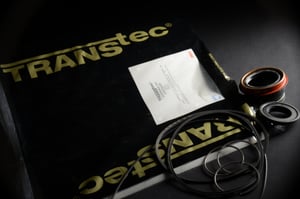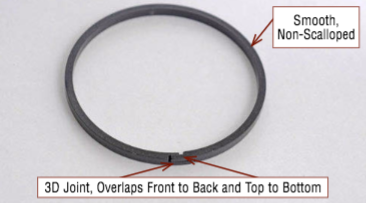Not All Sealing Rings Are Created Equal
 Sealing ring manufacturers are always looking for ways to improve the sealing abilities of the ring, as well as looking for ways to reduce wear. Many considerations go into ring design and material selection including fluid, temperature, rotational speeds, bore material, shaft material, surface finish & operating pressures. One design may work well when mating components are new and without wear, but not as well when wear becomes present. One design may be more forgiving than another design after wear of mating components.
Sealing ring manufacturers are always looking for ways to improve the sealing abilities of the ring, as well as looking for ways to reduce wear. Many considerations go into ring design and material selection including fluid, temperature, rotational speeds, bore material, shaft material, surface finish & operating pressures. One design may work well when mating components are new and without wear, but not as well when wear becomes present. One design may be more forgiving than another design after wear of mating components.
In our previous post, we discussed the various sealing ring designs for the RE5R05A transmission unit. When developing the RE5R05A rings, TransTec technicians used a combination of scallop and "T" shaped designs used for the sealing rings in the center support area. But why both?
Developing the RE5R05A Rings
TransTec® technicians have learned that the center support in the RE5R05A has an issue with wear on the ring lands. After some customer interactions, discussion with Freudenberg-NOK Fluid Power engineers and testing, it was determined that the “T” design would be more forgiving of wear in this area. This prompted exclusive use of the “T” design for the center support in TransTec® kits.
 The next set of rings is used on the mid sun gear shaft. Depending on the model of car, the set may contain four of the same rings, or two sets of two rings each. In units using the same four rings, the rings are made of PEEK material and designed with the scalloped 3D joint. In units using two sets with different designs, all four rings are made of PEEK, two rings are designed with the scalloped 3D joint and are located toward the front set of lands. The second set is located towards the rear and the rings are designed with a 3D joint but are not scalloped. TransTec® kits contain PEEK, non-scalloped 3D joint rings, because the design is much more forgiving for wear issues.
The next set of rings is used on the mid sun gear shaft. Depending on the model of car, the set may contain four of the same rings, or two sets of two rings each. In units using the same four rings, the rings are made of PEEK material and designed with the scalloped 3D joint. In units using two sets with different designs, all four rings are made of PEEK, two rings are designed with the scalloped 3D joint and are located toward the front set of lands. The second set is located towards the rear and the rings are designed with a 3D joint but are not scalloped. TransTec® kits contain PEEK, non-scalloped 3D joint rings, because the design is much more forgiving for wear issues.
 The last set of rings in the RE5R05A is for the output shaft. The designer chose to use rings made of Teflon® and PEEK, depending on the vehicle model and year. The PEEK rings are made with the scalloped 3D design, and the Teflon® rings are made with a butt cut design. TransTec® kits contain the Teflon® butt cut rings because they bench check better and perform well during normal operating conditions.
The last set of rings in the RE5R05A is for the output shaft. The designer chose to use rings made of Teflon® and PEEK, depending on the vehicle model and year. The PEEK rings are made with the scalloped 3D design, and the Teflon® rings are made with a butt cut design. TransTec® kits contain the Teflon® butt cut rings because they bench check better and perform well during normal operating conditions.
Quality Sealing Ring Designs
Not only is design of the sealing ring critical, manufacturing of the ring will also determine quality and ensure proper sealing within the application. Rings produced with low quality tools can display injector pin marks on one side of the ring. These marks are created by pins used to remove the ring from the tool. The injector pins displace material, creating a buildup of excess material or high spots. The displaced, or excess material can be high enough to create an insufficient contact with the ring land. Any area of the ring not making contact with the ring land is a leak path for oil. Conversely, rings produced with high quality tools will ensure a flat surface on the side of the ring because a sleeve, rather than ejector pins is used to eject the ring from the tool. The sleeve evenly distributes pressure across the surface of the ring avoiding material displacement.
On two-ring oil circuits, a builder can install the side with the injector pin marks toward the oil feed, which in turn will allow the smooth non-injector pin side to push tight against the ring land from the apply pressure, thus creating a sufficient seal. (The side of each ring that has the injector marks should face each other.) If there are more than two rings because there are multiple oil circuits being serviced, the technician should understand each circuit and install the rings with the injector marks in a circuit that has the least risk. Freudenberg-NOK strives to ensure that all sealing rings are manufactured with quality tooling and production processes, and that materials and designs meet the requirements of the transmission.


